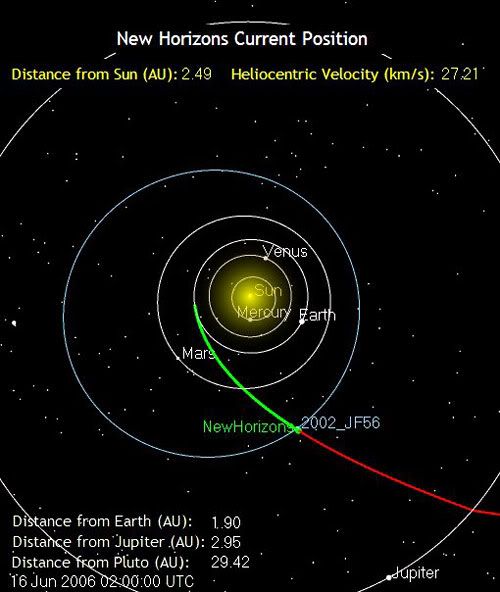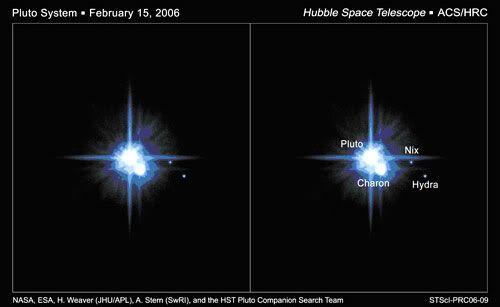
ABOVE: The green line marks the path traveled by the New Horizons spacecraft as of
7:00 PM, Pacific Standard Time, on June 15, 2006. It is 177 million miles from Earth.
Click here to view the official webpage showing where New Horizons is in space. (AU
stands for Astronomical Units, in case you're wondering.)
NEW HORIZONS Update... I mentioned in this earlier entry that I wouldn’t be talking about NASA’s Pluto mission again till the Jupiter encounter in February of 2007...unless sudden events warranted it. Well— A few weeks ago, New Horizons principal investigator Alan Stern mentioned that the spacecraft was going to pass by a 3-mile long asteroid dubbed 2002 JF56 on June 13...that is, two days ago. New Horizons came within 63,500 miles of the distant body. Although 2002 JF56 appears as a mere white speck in the photo below, the encounter was still a success for the New Horizons flight team, as this flyby was nothing more than a test to see how well the 'Ralph' camera (which took the image) onboard the spacecraft was able to track and photograph moving objects. Although the moons of Jupiter will appear to be zipping by much more slowly than 2002 JF56 during the Jovian flyby next year, New Horizons will be flying through the Pluto system at a brisk 31,000 miles per hour in 2015. So it’s a good thing that the spacecraft had the opportunity to pass by this Main Asteroid Belt object. New Horizons could’ve actually shot better images of 2002 JF56 if it used LORRI (the LOng-Range Reconnaissance Imager) instead, but LORRI is an extremely-sensitive camera and cannot open its lens cover till late August...since sunlight at the spacecraft’s current distance from the Sun (232 million miles) would damage the instrument.

ABOVE: Asteroid 2002 JF56, through
the eyes of New Horizon's 'Ralph'
camera from 883,000 miles away.
Speaking of the Main Asteroid Belt (which is between Mars and Jupiter for those of you who never took an astronomy class, haha), New Horizons entered this vast, 113 million mile-wide region early this month and won’t be emerging from it till August.
NEW HORIZONS Blog Entries Archive:
September 26, 2005
December 19, 2005
January 7, 2006
January 17, 2006
January 19, 2006
April 12, 2006
June 15, 2006
EDIT (June 22): This week, the International Astronomical Union officially gave names to Pluto's two recently discovered moons. They are Nix and Hydra. Nix is the innermost moon orbiting Pluto and Hydra is the outermost moon. For more information on why these two names were selected, click here. As for what the International Astronomical Union is, it is the worldwide governing body responsible for giving celestial objects like planets and asteroids their names (mostly Greek and Roman monikers)... Think "U.N." without the sanctions, but with a lot of geeky talk.


No comments:
Post a Comment